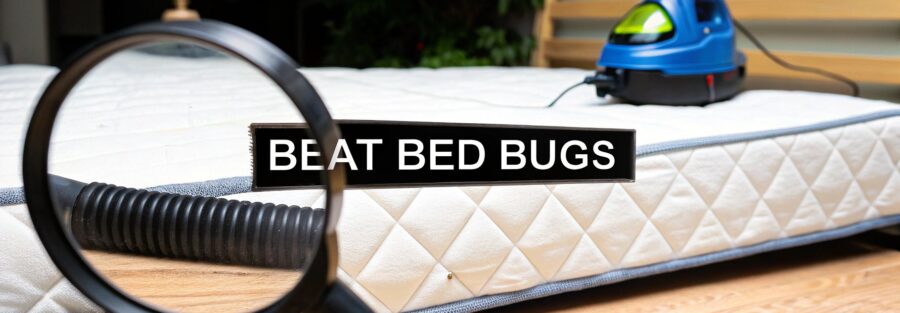Before you even think about starting any kind of treatment, you have to be 100% sure you’re dealing with bed bugs. It’s a classic mistake to jump the gun based on a few mysterious bites, but that can be a costly error. Many different things can cause skin irritation, so the first real step is to find hard, physical proof.
Confirming You Have a Bed Bug Problem
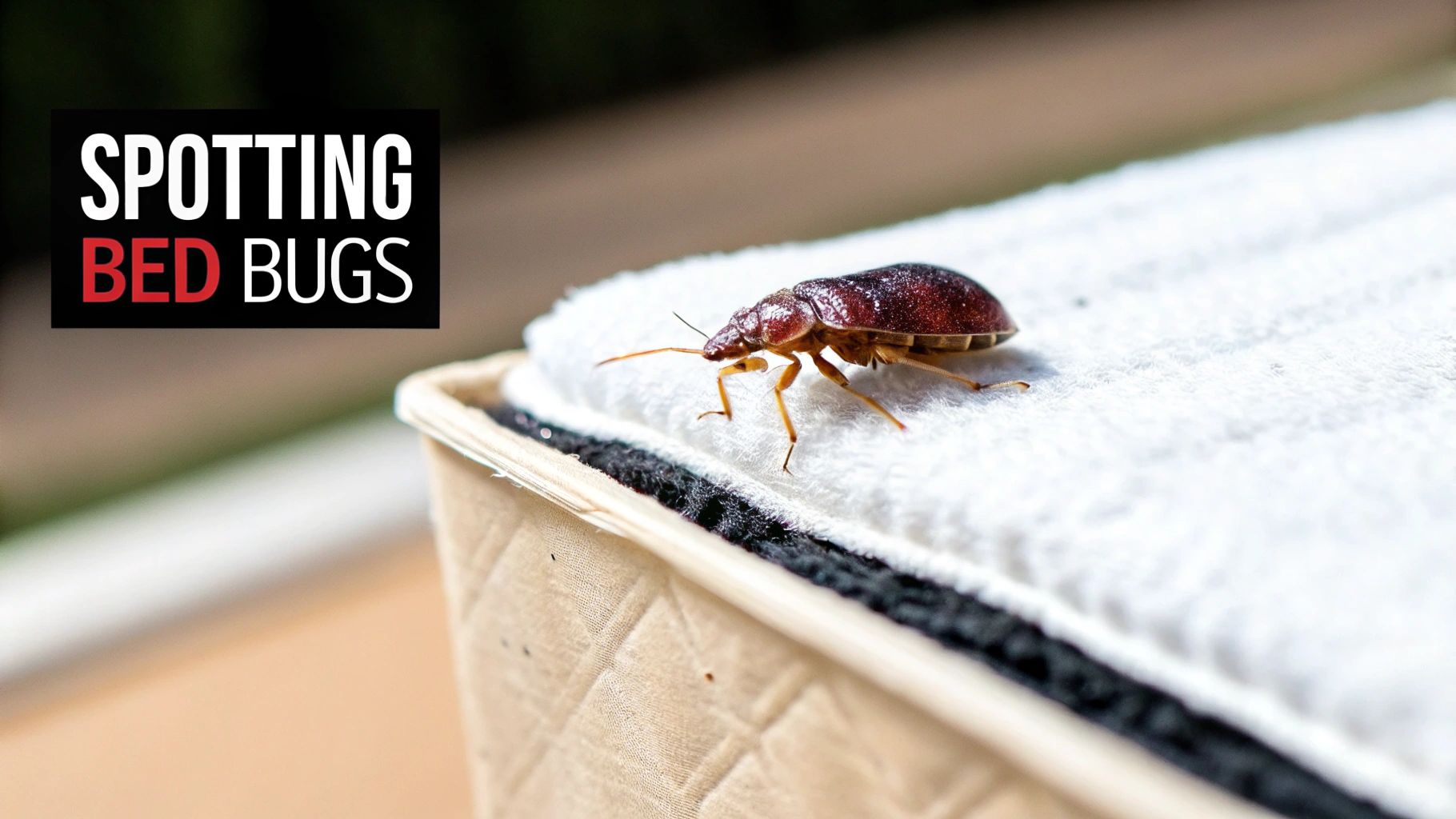
Trying to diagnose an infestation based on bites alone is a gamble. Honestly, it's not reliable at all. Some people don't react to bed bug bites whatsoever, while for others, the red, itchy welts look just like mosquito bites or a bout of hives. This is exactly why an infestation can quietly grow for weeks, or even months, before anyone realises what's happening.
And it’s a growing problem. In 2023, UK councils were called out to over 14,587 official bed bug complaints, which is a massive 23% jump from the year before. This isn't just a nuisance; it's becoming a genuine public health challenge, especially in places like London where population density and international travel create the perfect storm.
Looking for Physical Evidence
Right, it's time to play detective in your own home. You'll need a good, strong torch—the one on your phone might not be bright enough—and a magnifying glass will be a massive help. The key is to be methodical and look for the undeniable signs of bed bugs, not just guess based on bites.
Here are the tell-tale clues you're searching for:
- Live Bugs: An adult bed bug is reddish-brown, flat, and oval, roughly the size of an apple seed. The young ones, called nymphs, are much smaller and can be almost see-through.
- Faecal Spots: These look like tiny black ink dots on fabric. It’s digested blood, and if you wipe a spot with a damp cloth, it will often smear.
- Shed Skins (Exoskeletons): As they grow, bed bugs shed their skin. You'll find these pale, husk-like casings left behind in their hiding spots.
- Tiny Eggs: Bed bug eggs are about 1mm long and a pearly white colour. They're usually laid in tight clusters inside cracks and are incredibly tough to see without a magnifying glass.
Common Hiding Spots
Bed bugs are masters of concealment. They squeeze into the tiniest, most out-of-the-way cracks they can find, but they always stay close to their next meal: you. That means your search should start in and around your bed.
Begin your inspection in these key areas:
- Mattress and Bed Base: Check every single seam, tuft, and tag on your mattress. Then, lift the mattress off completely and inspect the bed base or box spring, paying close attention to the fabric stapled underneath.
- Bed Frame and Headboard: If you can, take the bed frame apart. Look inside every joint, screw hole, and crack. Pull the headboard away from the wall and give the back of it a thorough check.
- Nearby Furniture: These pests don't limit themselves to the bed. Open up bedside tables and chests of drawers, checking the corners and joints inside. Don't forget to inspect any upholstered chairs or sofas in the room.
A very common mistake is to only check the mattress. I’ve been to jobs where the mattress looked almost clear, but the real infestation was hidden deep inside the wooden slats of the bed frame or behind a peeling bit of wallpaper right next to the bed.
Once you’ve scoured the immediate bed area, widen your search. Look behind picture frames, under loose wallpaper, inside electrical sockets, and even within the folds of your curtains. A good rule of thumb is that if a credit card can slide into a gap, a bed bug can get in there too.
Properly identifying the pest is the foundation of any successful bed bugs treatment. If you're still not sure what you're looking at, comparing your findings with pictures of the different types of bugs in beds can help bring some clarity.
Prepping Your Home for Treatment Success
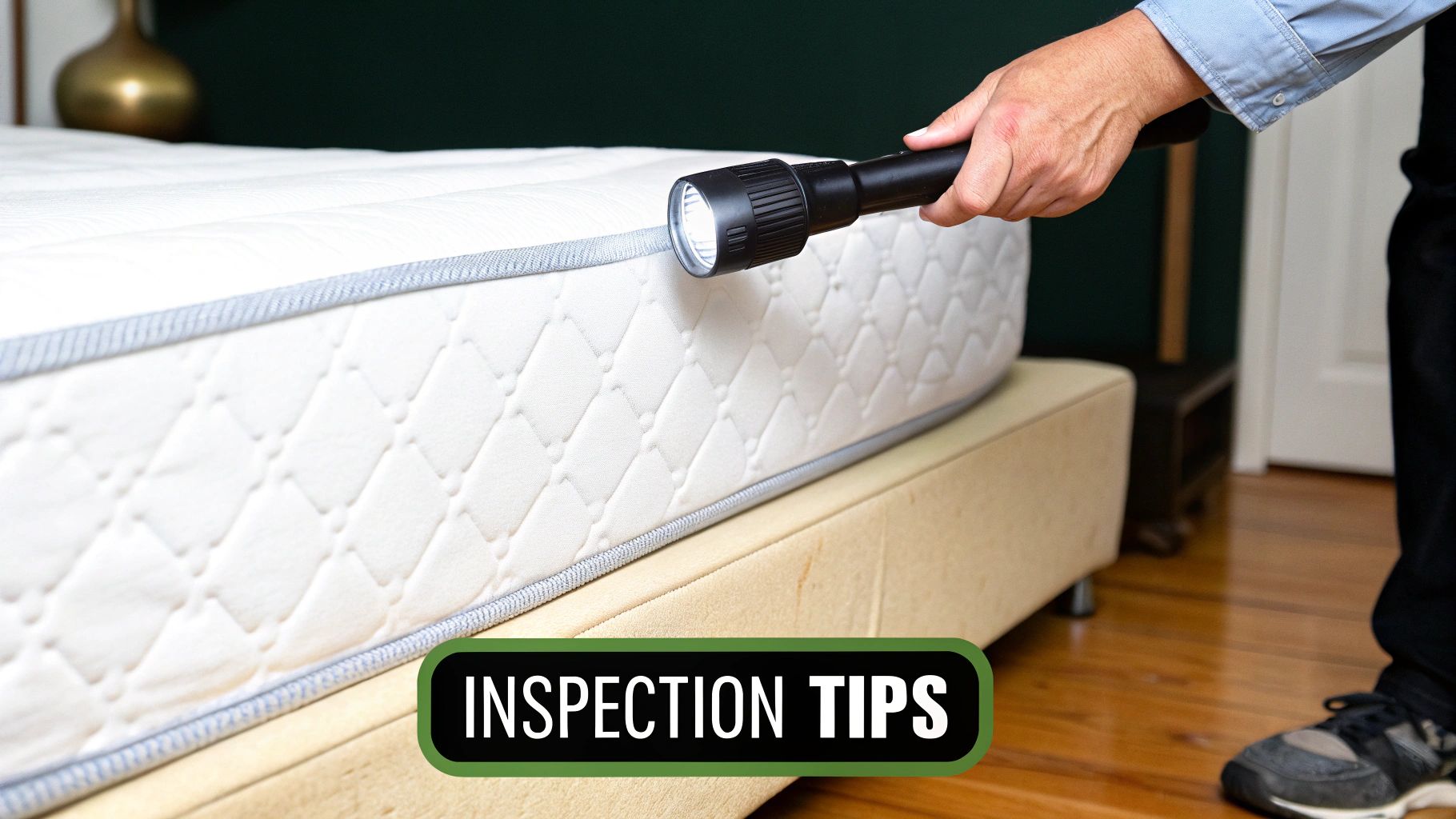
Whether you’re going the DIY route or calling in the professionals, the prep work you do beforehand is absolutely critical. Think of it like this: a rushed or incomplete prep is one of the biggest reasons I've seen any bed bugs treatment fail, landing you right back at square one.
You're essentially clearing the battlefield. The main goal is to strip away all their potential hiding places so that the treatment—be it heat, steam, or a chemical application—can get into every last crack and crevice where they live and lay their eggs. This needs to be a systematic process, not just moving clutter from one pile to another.
Decluttering with a Plan
Bed bugs are experts at exploiting clutter. That pile of clothes on a chair, the stack of books by the bed, or the boxes you’ve been meaning to clear out are all five-star hotels for them. Your first mission is to get rid of it all, but you have to do it carefully to avoid accidentally spreading the infestation.
Get some heavy-duty bin bags and work through the infested room methodically. Anything you're throwing away—old magazines, unwanted paperwork, general junk—goes straight into a bag. Seal it up tight inside the room before you move it, and get it into an outside bin immediately.
For everything you’re keeping, sort it all into two main piles: washable fabrics and non-washable items. This simple separation makes the next stage much more manageable.
Handling Fabrics and Soft Furnishings
Anything made of cloth is a potential Trojan horse for bed bugs. We're talking bedding, clothes from every drawer and wardrobe, curtains, rugs, and even the kids' stuffed animals. Every single piece needs to be handled as if it's contaminated.
Here’s the process I always recommend:
- Bag Everything in Place: Before moving anything, put all washable items into plastic bags and seal them tightly. Don't carry loose armfuls of laundry through the house, as you’ll likely be dropping eggs or even live bugs as you go.
- High-Heat Wash: Take the sealed bags directly to the washing machine. You'll need to wash everything on a hot cycle—at least 60°C—to kill bed bugs at all life stages.
- Tumble Dry for at Least 30 Minutes: This is the most important step. After the wash, put everything in the tumble dryer on the highest heat setting for a minimum of half an hour. The sustained dry heat is what really finishes them off.
- Store in Fresh Bags: Once the items are clean and bone-dry, place them into new, clean bags. Seal these and keep them out of the infested room until the all-clear is given post-treatment.
What about delicates that can't be washed? A hot cycle in the tumble dryer on its own can often do the trick. If that's not an option, professional dry cleaning works too, but you have a responsibility to tell the cleaner what they're dealing with beforehand.
A hot wash is good, but skipping the high-heat drying stage is a classic mistake. I’ve seen infestations persist because of it. It’s the prolonged, intense heat of a tumble dryer that gives you the highest chance of killing every last bug and egg.
The Power of Thorough Vacuuming
Your vacuum cleaner is your best friend in this fight. Used correctly, it can physically remove a huge number of bugs and eggs before any treatment even starts.
You need to be meticulous. Focus your efforts here:
- The Bed Itself: Use the crevice tool to get right into the seams and tufts of the mattress. Vacuum the entire bed base, paying special attention to joints, slats, and screw holes.
- All Other Furniture: Pull off the cushions from sofas and chairs and vacuum underneath. On wooden furniture like dressers or nightstands, use the crevice tool along joints and inside empty drawers.
- Floors and Skirting Boards: Go over the entire carpet, but concentrate on the edges where the carpet meets the skirting boards. That tiny gap is a prime bed bug highway.
When you’re done, what you do next is absolutely vital. Take the vacuum outside immediately. If it has a bag, remove it, seal it in another plastic bag, and put it straight in your outdoor bin. For bagless models, empty the contents into a sealed bag outside, and then wash the collection canister thoroughly with hot, soapy water to kill any stragglers.
Choosing the Right DIY Bed Bug Treatments
If you’ve managed to catch a bed bug problem early and it seems confined to one area, tackling it yourself can be a viable option. But let's be clear: success hinges on being incredibly thorough and using the right mix of methods. This isn't about finding a single magic spray; it's about a multi-pronged attack.
The best DIY strategies are built on what professionals call Integrated Pest Management (IPM). It’s a fancy term for a simple idea: you’re not just relying on a can of chemicals. Instead, you'll combine physical removal, clever non-chemical barriers, and a targeted, careful use of approved products to wipe them out.
Your First Line of Defence: Non-Chemical Tactics
Before you even think about insecticides, your initial assault should involve physical tools that kill or trap bed bugs without any toxins. These methods are safe, surprisingly effective, and should be the foundation of any serious DIY plan.
Here's where to start:
- Mattress Encasements: These are absolutely essential. A high-quality, bite-proof encasement zips securely around your entire mattress and box spring. This traps any bugs already inside and, just as importantly, stops new ones from getting in. You’ve just neutralised their favourite hiding spot.
- Interceptor Traps: These simple-looking plastic dishes are placed under each leg of your bed frame. They have a rough outer surface bed bugs can easily climb, but a slippery inner well they can't escape. They're a brilliant, low-cost way to catch bugs and monitor how bad the problem is.
- High-Heat Steam: Heat is a bed bug's greatest weakness. A good quality steamer that produces steam over 100°C will kill both live bugs and their eggs instantly on contact. It’s perfect for getting into mattress seams, bed frame joints, and the nooks and crannies of upholstered furniture.
For carpets and soft furnishings, the heat needs to go deep. Sometimes, home steamers just don't have the power to penetrate thick fibres where bugs and eggs might be hiding. In these cases, professional deep steam carpet cleaning services can be a powerful non-toxic weapon in your arsenal.
Comparing DIY Bed Bug Treatment Methods
When you're standing in the pest control aisle, it's easy to get overwhelmed. Not all DIY treatments are created equal. This table breaks down some of the most common options to help you decide what's right for your situation.
| Method | Effectiveness Rating | Average Cost (UK) | Best For | Safety Considerations |
|---|---|---|---|---|
| Mattress Encasements | High | £20 – £60 | Trapping bugs on mattresses/box springs and preventing re-infestation. | Non-toxic. Ensure it's certified bite-proof and tear-resistant. |
| Interceptor Traps | High (for monitoring) | £10 – £25 (for 4-8) | Placing under bed/furniture legs to monitor activity and catch bugs. | Completely non-toxic and safe around pets and children. |
| High-Heat Steamer | High | £40 – £150 | Direct contact killing on surfaces like furniture, curtains, and carpets. | Risk of burns. Keep away from children. Avoid using on delicate fabrics. |
| Diatomaceous Earth (DE) | Moderate | £10 – £20 per bag | Applying as a fine dust in cracks, crevices, and wall voids. | Use food-grade DE. Wear a mask during application to avoid inhaling dust. |
| OTC Sprays (Pyrethroid) | Low to Moderate | £5 – £15 per can | Limited spot treatment, but resistance is a major issue. | Follow label instructions precisely. Ventilate the area well. Keep away from pets. |
Ultimately, the most effective DIY plans don't rely on just one of these. A combination of encasements, interceptors, and heat treatment is often the most powerful and safest approach before resorting to chemicals.
Using Chemical Treatments Safely and Smartly
While non-chemical methods are your heavy hitters, a small infestation might still need the careful use of insecticides to finish the job. The trick is choosing the right product and understanding that bed bugs have become resistant to many common over-the-counter sprays.
Don't just grab the first can you see labelled "bed bug killer." Many common pyrethroid-based insecticides are now virtually useless against a large portion of the bed bug population. You'll just be wasting your time, money, and filling your home with chemicals for no good reason.
When you do opt for a chemical, look for products that contain a mix of active ingredients or those from different chemical classes, as this can sometimes overcome resistance. Always, always read the label and follow the application instructions to the letter.
This chart shows how to use a certified insecticide as part of a proper treatment cycle.
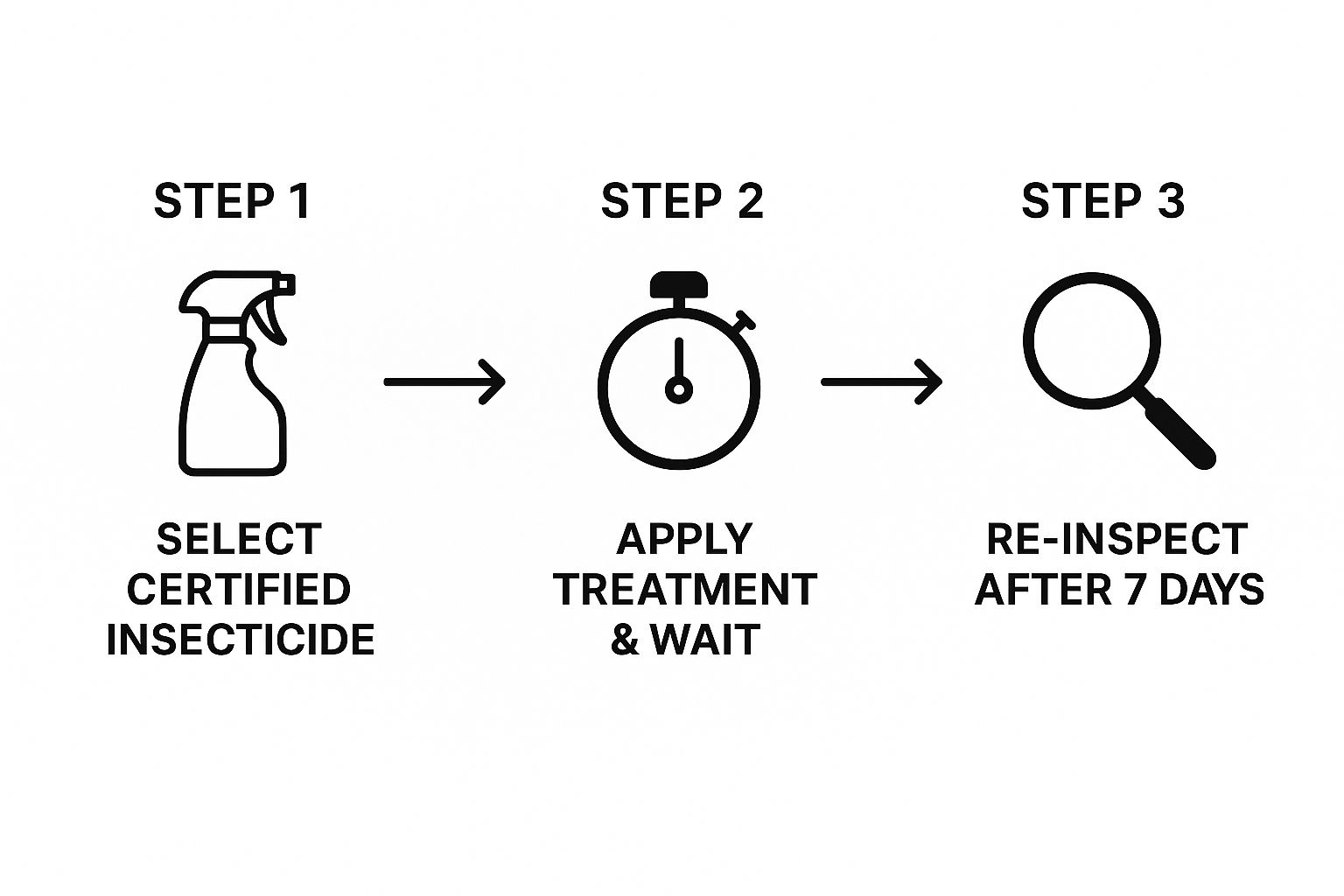
As you can see, spraying isn't a one-and-done solution. It's a process of treating, waiting, and re-inspecting carefully.
One of the most effective powders available is diatomaceous earth (DE). This is a natural dust made from fossilised algae. It kills bed bugs not by poison, but by scratching through the waxy outer layer of their exoskeleton, which causes them to dehydrate and die.
The secret to using DE is applying a very fine, almost invisible layer. A common mistake is piling it up in clumps; the bugs will just walk around it. Use a small puffer or duster to apply it strategically:
- Inside cracks and joints of the bed frame.
- Along skirting boards, especially behind the bed.
- Behind electrical socket covers (with the power off!).
- Under the legs of furniture where your interceptor traps are.
Knowing When to Throw in the Towel
Let's be honest: a DIY approach is a lot of hard work and requires real persistence. You have to be realistic about the scale of the infestation and recognise when you're out of your depth.
If you’ve thoroughly treated the bedroom but then start getting bitten on the sofa, it’s a clear sign the infestation has spread. Likewise, if you've done everything by the book for several weeks and you're still finding live bugs in your traps, your efforts aren't keeping up with their breeding cycle.
At that point, continuing to go it alone can allow the problem to become deeply entrenched, making it far harder and more expensive to fix later. The best bed bugs treatment is one that gets rid of them completely, and sometimes, that means admitting defeat and calling in the experts.
When to Hire a Professional Pest Controller
Sometimes, you have to know when to call it a day. If you’ve been fighting bed bugs with everything you’ve got and they’re still winning, bringing in a professional isn’t admitting defeat—it's making a smart, strategic move to get your home back. Sticking with a failing DIY approach only gives the infestation more time to dig in, making it much harder and more expensive to sort out later.
There are a few tell-tale signs that the problem has gotten bigger than you can handle on your own. Have you been meticulously treating for weeks but still find live bugs or wake up with fresh bites? That’s a clear sign they’re breeding faster than you can kill them.
Another red flag is finding them in more than one room. If you’ve treated the bedroom only to find them on the sofa a week later, it means they’ve spread. An infestation on that scale needs a far more comprehensive approach than most shop-bought products can offer.
The Professional Treatment Advantage
When you hire a reputable pest control service, you’re not just paying for stronger chemicals. You're paying for their expertise, their specialised equipment, and a proven method that works. Professionals have access to treatments that simply aren't sold to the public, many of which are specifically designed to kill bed bugs that have grown resistant to common insecticides.
This is a massive issue across the country. Between 2022 and 2024, the UK saw a shocking 35% increase in bed bug call-outs to pest controllers. This surge shows just how fast these pests are spreading and adapting. The problem is made worse by a postcode lottery for pest control, leaving some people to fight a losing battle alone. You can read more about the rising pest challenges across the UK.
Understanding Professional Methods
Professional pest controllers in the UK generally use two main weapons to get rid of bed bugs for good.
-
Professional Heat Treatments: This is widely seen as the gold standard. Technicians bring in powerful, specialised heaters to raise the temperature of a room to between 50°C and 60°C. They hold it there for several hours, a temperature that’s lethal to every stage of the bed bug life cycle, from egg to adult. The beauty of heat is that it gets everywhere—deep into mattresses, behind skirting boards, and inside wall voids where sprays can't reach.
-
Professional-Grade Insecticides: Forget the weak sprays from the supermarket. Pest controllers use a cocktail of fast-acting contact killers and residual insecticides that keep working for weeks. Crucially, they’re trained to apply these chemicals safely and precisely into the tiny cracks and crevices where bed bugs love to hide, ensuring they hit their target with minimal risk to your family and pets.
Some companies are also starting to use innovative solutions like fungal biopesticides. These contain natural fungal spores that stick to a bed bug's body, infecting and killing it. It’s another powerful tool in the arsenal, especially against insecticide-resistant bugs.
The real value of a professional isn’t just their kit, but their knowledge. An experienced technician knows bed bug behaviour inside out. They know exactly where to look and how to apply treatments for the best results—something you only learn from years on the job.
Choosing the Right Pest Control Service
Deciding to call for help is the first step, but picking the right company is just as important. A botched professional treatment can be every bit as frustrating as a failed DIY one.
When you're looking for a service, start by checking for membership in a recognised trade body like the British Pest Control Association (BPCA). Being a member means the company follows a strict code of practice and its technicians are properly trained and insured.
Always ask for a detailed treatment plan and a clear quote before you agree to anything. A good company will insist on a thorough inspection first, and they’ll be upfront about costs, any necessary follow-up visits, and what guarantees they offer. This kind of transparency is the hallmark of a professional bed bugs treatment that’s tailored to your home.
If you're keen to understand the professional methods in more detail, you might find our guide on how heat treatment works to eliminate bed bugs useful.
Keeping Your Home Bed Bug Free After Treatment
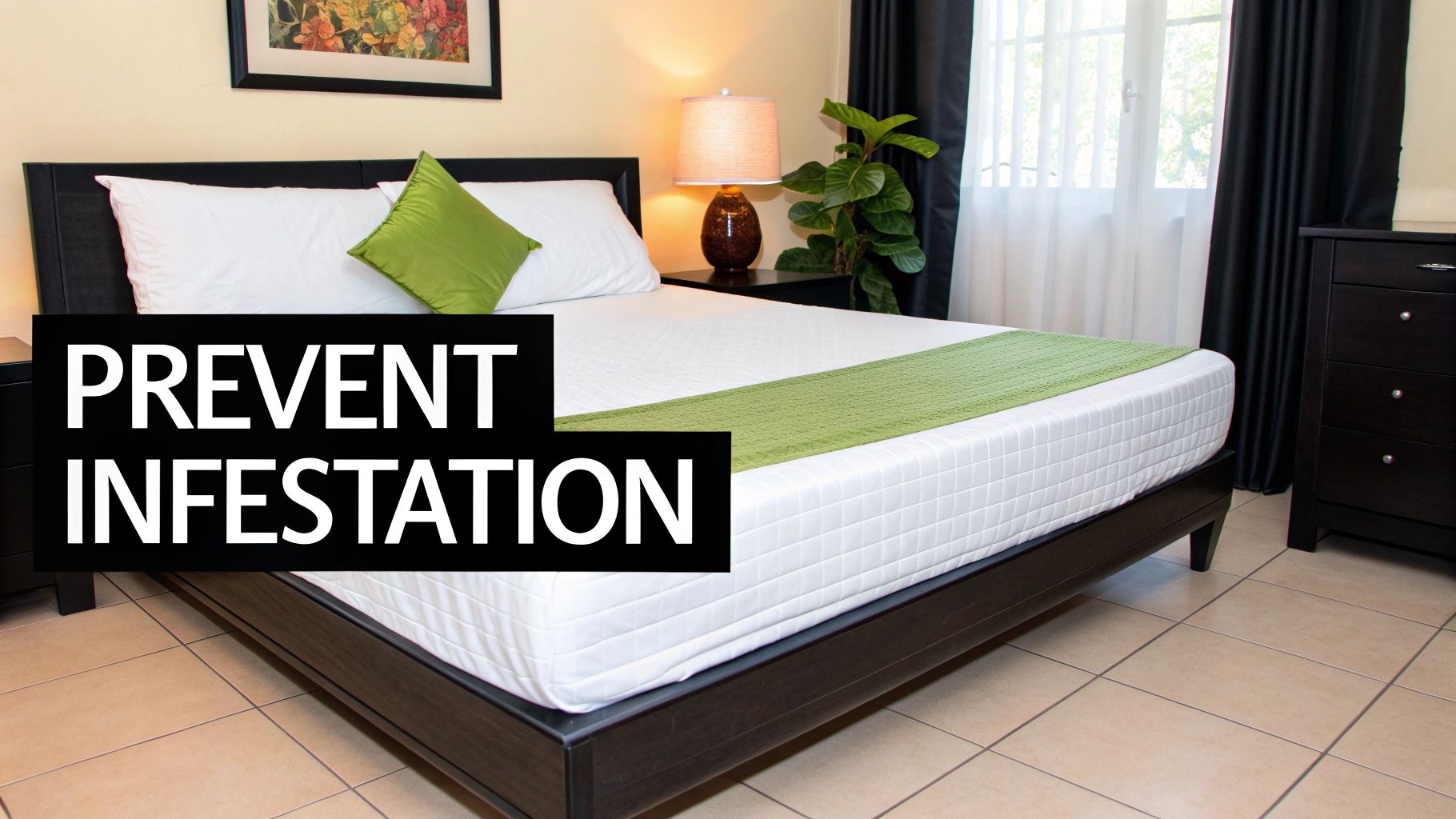
You’ve made it through the treatment process, which is a massive relief. But the job isn't quite over. Now, the focus needs to switch from getting rid of bed bugs to keeping them gone for good.
This final stage is all about being vigilant. A proactive mindset is your best defence against a re-infestation, ensuring all that hard work wasn't for nothing. A simple but consistent strategy for monitoring and prevention will give you lasting peace of mind.
Monitoring for Lasting Success
After any treatment, you need to be certain every last bug has been dealt with. The worst thing you can do is just wait to see if you get bitten again—that gives any stragglers a golden opportunity to regroup and start breeding. Instead, you need to actively monitor the situation.
Interceptor traps are a brilliant tool for this. Just pop one under each leg of your bed frame and have a quick look at them each week. Think of them as an early warning system. Finding even a single bug in a trap tells you there's still a problem, letting you act fast before a small issue becomes a full-blown infestation.
Alongside the traps, get into the habit of doing regular visual checks. Once a month, grab a torch and spend ten minutes checking the usual hiding spots: mattress seams, the nooks and crannies of the bed frame, and behind the headboard. It’s always easier and cheaper to solve a problem you catch early.
Adopting a Proactive Prevention Mindset
Preventing a new infestation is far less stressful than dealing with an existing one. Most of the time, bed bugs are brought into a home from outside. This means a few simple, cautious habits can make all the difference, especially if you travel often or live in an apartment building.
Here are a few practical actions you can take:
- Inspect Hotel Rooms: Before you even think about unpacking on holiday, give the room a quick once-over. Check the mattress seams and the headboard for any tell-tale signs. And always use the metal luggage rack—never put your suitcase on the floor or the other bed.
- Handle Luggage with Care: When you get home, unpack your suitcase in the garage or outside if you can. Every piece of clothing should go straight into the washing machine for a hot wash, followed by a hot tumble dry. Give the suitcase itself a thorough vacuum before you put it away.
- Be Cautious with Second-Hand Items: That lovely vintage armchair or antique dresser from a car boot sale could be hiding unwanted hitchhikers. Give any second-hand furniture a meticulous inspection before it crosses your threshold.
Investing in high-quality mattress and pillow encasements is one of the best long-term preventative moves you can make. They completely seal off the primary hiding and breeding spots, turning your bed into a fortress that bed bugs can't penetrate.
Future-Proofing Your Home
The battle against bed bugs is always changing, especially as they build up resistance to common insecticides. Researchers in the UK are constantly looking for new ways to stay ahead. One recent study found that applying specialised tape to bed frames cut bed bug numbers by 86% in just six weeks.
Newer, promising solutions are also on the horizon, like biocontrol agents that use a natural fungus to kill the bugs. These innovations are shaping the future of pest control.
By combining diligent monitoring with smart, preventative habits, you’re creating layers of defence that make your home a much less attractive target for bed bugs. If you're interested in long-term, sustainable protection, looking into eco-friendly pest control options can offer solutions that are safe for your home and the environment.
Common Questions About Bed Bug Treatments
Discovering you have bed bugs is stressful enough without having to wade through confusing information. When you're dealing with the anxiety and sleepless nights, you just need clear, straight answers. Let's tackle some of the most common questions I hear from clients, cutting through the noise to give you the practical information you need.
You're not the first person to deal with this, and you won't be the last. These pests are notoriously tricky, but understanding what you're up against is the first step toward taking back control. From how long it all takes to whether they can live in your hair, let's get you some answers.
How Long Does Treatment Take to Work?
This is always the first question, and understandably so: "When will they be gone?" The honest answer is that it varies, depending heavily on the treatment type and just how bad the infestation has become. It's almost never a one-and-done magic bullet.
Heat treatments are by far the fastest route. A professional can often clear an entire infestation in a single day. The process takes several hours, but the huge advantage is that you can usually return to a bed bug-free home that very evening.
Chemical treatments, on the other hand, are more of a waiting game. You'll see a massive drop in bed bug activity within the first week after the initial service. However, insecticides don't kill the eggs. That’s why a follow-up treatment is almost always booked for 2-3 weeks later. This second visit is designed to catch the newly hatched nymphs before they have a chance to grow up and start the cycle all over again.
Can Bed Bugs Live in My Hair or on My Body?
I get this question a lot, and it comes from a place of real fear. Thankfully, the answer is a firm no. Unlike fleas or lice, bed bugs simply aren't built for living on a host. Their legs and claws can't grip onto hair or skin, so they have no way to hang on.
Their entire strategy is to be stealthy. They emerge from a nearby hiding spot—like the seam of your mattress or a crack in the headboard—take a blood meal, and then quickly retreat to safety. While they crawl on you to feed, they have zero interest in setting up camp there. This means you never need to treat your body or hair as part of any bed bugs treatment.
A key takeaway is that bed bugs are a structural pest, not a personal hygiene issue. Their presence is about finding safe harbourage near a food source, not about the cleanliness of a person.
Understanding this helps you focus your energy where it matters: treating your room and furniture, not yourself.
Is It Possible for Treatments to Fail?
Unfortunately, yes. Treatment failure is a real risk, and it’s most common with DIY attempts. From my experience, failures usually happen for a few key reasons: the treatment wasn't thorough enough, the true scale of the infestation was underestimated, or the products used were ineffective against resistant bed bug populations.
Even professional treatments can run into trouble, often due to poor preparation. If a room is full of clutter, for instance, there’s no way for the heat or chemical spray to reach every last hiding spot. That just leaves a pocket of survivors ready to repopulate.
To give yourself the best shot at success:
- Prepare Meticulously: When your pest controller gives you a prep sheet, follow it to the letter. Decluttering is non-negotiable.
- Be Completely Honest: If you’ve seen a bug in the living room, say so. Hiding the full extent of the problem will only lead to failure.
- Commit to the Follow-Up: Never cancel the second or third scheduled visit. It’s absolutely essential for breaking their life cycle.
Any good pest control company will stand by their work with a guarantee. This is one of the biggest reasons to bring in an expert for anything more than a minor issue. Before you hire anyone, make sure you ask them about their guarantee policy—it's your peace of mind.
If you're facing a stubborn infestation and need guaranteed results, Pest Predators Limited offers expert, evidence-based solutions. Our qualified biologist leads a team dedicated to providing effective and sustainable pest control. Contact us for a consultation and take the first step towards a pest-free home. Learn more at https://www.pestpredatorslimited.co.uk.

